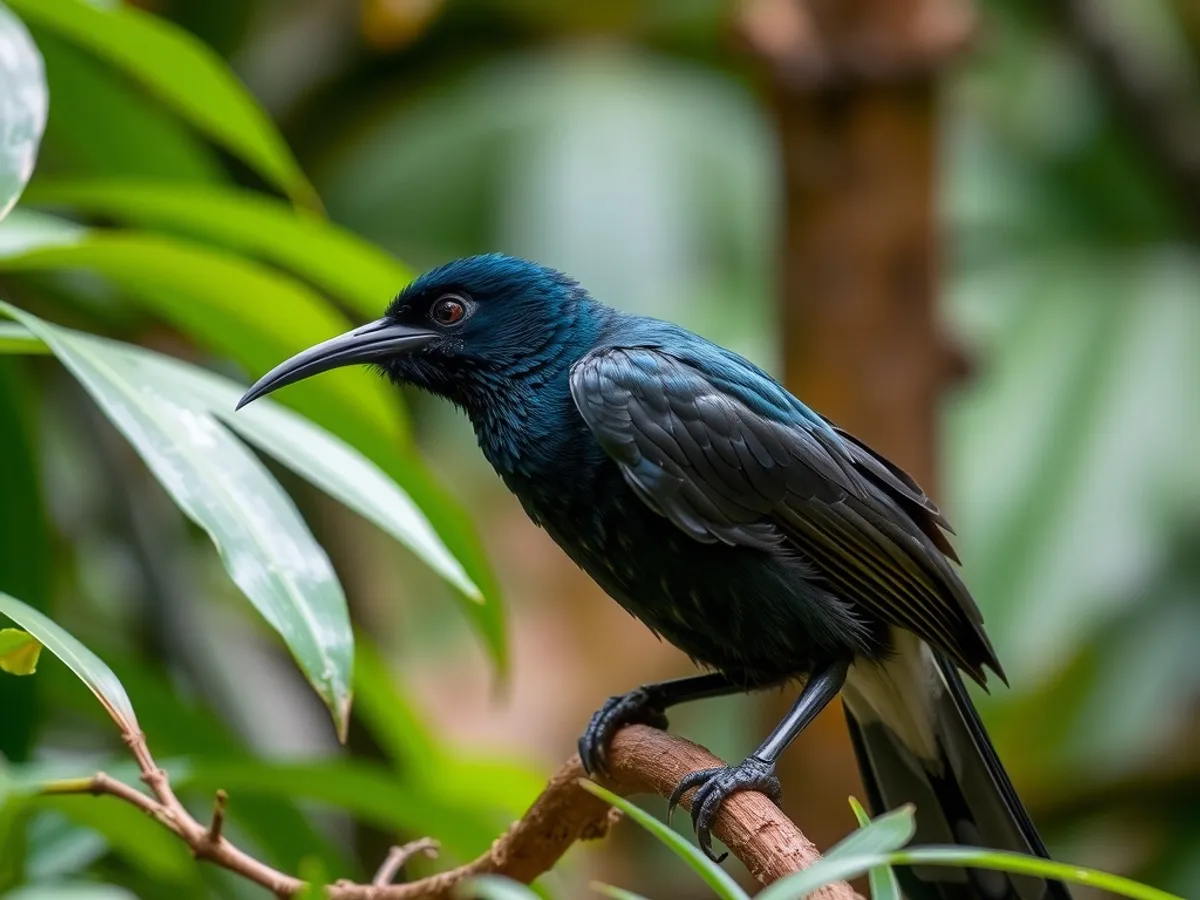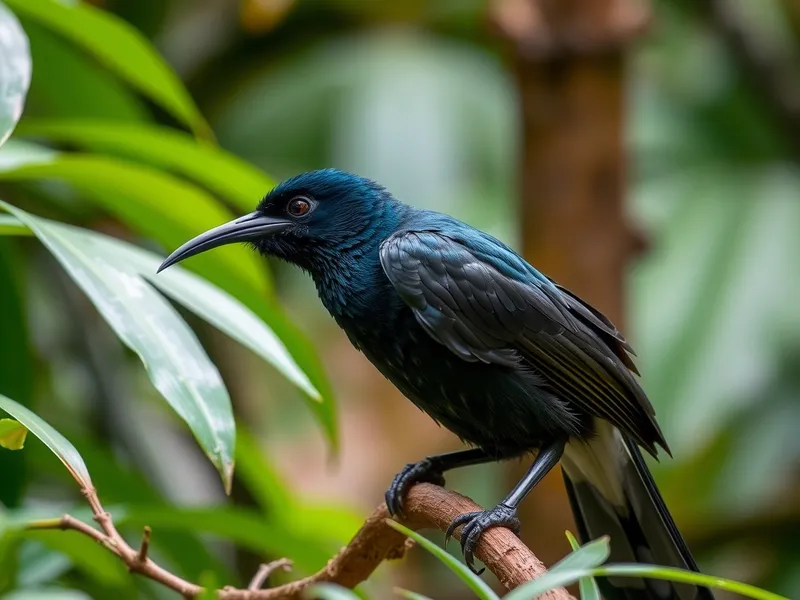
Magnificent Riflebird
Ptiloris magnificus

Meet the Magnificent Riflebird
The Magnificent Riflebird is a striking member of the birds-of-paradise family, renowned for its velvety black plumage in males, adorned with an iridescent blue-green breast shield and crown. Native to the lowland rainforests of New Guinea and northern Australia, this species is famous for its elaborate mating display, where the male fans out his wings and shimmers his feathers to attract females. Females possess more cryptic brown plumage, which helps them remain inconspicuous while nesting. The Magnificent Riflebird is an important part of its ecosystem, contributing to seed dispersal through its varied diet.
Classification
Bird
Habitat
Tropical rainforest
Diet
Omnivore
Lifespan
5-8 years
Conservation
Least Concern
Weight
180-230 grams
📖Fascinating Facts
Spectacular Courtship
The male's courtship display involves spreading his wings into a circular cape and rhythmically moving them while making distinctive calls to attract females.
Rainforest Resident
Magnificent Riflebirds are primarily found in the lowland and foothill rainforests of New Guinea and the Cape York Peninsula in Australia.
Fruit Lover
Their diet consists mainly of fruits and insects, making them important seed dispersers in their habitat.
📋Detailed Description
The Magnificent Riflebird (Ptiloris magnificus) is a medium-sized passerine, measuring approximately 29–34 cm in length, with males typically larger than females. Males are renowned for their glossy, velvety black plumage, highlighted by a striking iridescent blue-green breast shield and a metallic crown, features that play a crucial role in courtship displays. Their elongated, curved bills are adapted for probing and foraging, while their strong legs and feet facilitate agile movement through dense rainforest understory. Females, in contrast, exhibit cryptic brown and buff plumage with subtle barring, providing camouflage while nesting. Both sexes possess a relatively short tail compared to other birds-of-paradise. The species has a robust, slightly decurved bill suited to an omnivorous diet. The Magnificent Riflebird is primarily arboreal, spending most of its time in the mid to upper canopy of lowland and hill rainforests. Its vocalizations are distinctive, with males producing a loud, ringing 'yaassss' call during displays. The species is solitary outside of the breeding season, with males occupying and defending display territories known as leks. Their role as seed dispersers and insect predators makes them ecologically significant within their habitat.
💡 Did you know?
The Magnificent Riflebird is one of the few birds capable of independently rotating its wings forward during its courtship dance, creating a dramatic visual effect.
🔬Research & Sources
Wikipedia Summary
The magnificent riflebird is a species of passerine bird in the birds-of-paradise family Paradisaeidae.
Last Modified: 2/25/2025
🎭Behavior & Social Structure
Magnificent Riflebirds are diurnal and highly territorial, especially during the breeding season when males establish and maintain display courts. Males meticulously clear a small patch of forest floor or a horizontal branch to serve as a stage for their elaborate courtship displays, which involve spreading their wings, raising their breast shield, and performing rhythmic side-to-side movements. These displays are often accompanied by complex vocalizations and mechanical sounds produced by wing flicks. Feeding behavior is opportunistic; they consume a variety of fruits, berries, arthropods, and small invertebrates, foraging primarily in the canopy but occasionally descending to lower levels. The species is generally solitary, with minimal social interaction outside of mating contexts. Daily routines include periods of foraging interspersed with rest and preening. Females are more secretive, especially when nesting, and exhibit cryptic behaviors to avoid predation.
👶Reproduction & Life Cycle
The breeding season varies regionally but generally coincides with the austral spring and early summer (August to February). Males are polygynous, attracting multiple females to their display sites but providing no parental care. After mating, the female alone constructs a cup-shaped nest from leaves, twigs, and moss, typically positioned 2–10 meters above ground in dense foliage. Clutch size is usually one, occasionally two, eggs, which are incubated solely by the female for about 17–18 days. Chicks are altricial and remain in the nest for approximately 18–22 days before fledging. The female provides all parental care, feeding the chicks a diet of insects and fruit. Fledglings are dependent on the mother for several weeks post-fledging.
🛡️Adaptations & Survival
The Magnificent Riflebird exhibits several remarkable adaptations. Males have evolved specialized iridescent plumage and complex display behaviors as a result of intense sexual selection. Their visual displays are enhanced by the unique microstructure of their feathers, which manipulate light to produce vivid colors. The species' strong, decurved bill allows efficient extraction of fruit pulp and invertebrates from crevices. Their cryptic female plumage is an adaptation for nest concealment and predator avoidance. Behavioral adaptations include the use of specific display sites and the ability to learn and refine display routines over time, indicating advanced cognitive abilities. Their wide gape and flexible tongue facilitate the consumption of a diverse diet.
🎨Cultural Significance
The Magnificent Riflebird holds cultural importance among indigenous communities in New Guinea, where its feathers were traditionally used in ceremonial attire and ornamentation. The bird's striking appearance and elaborate displays have made it a symbol of beauty and courtship in local folklore. In Western culture, it is celebrated for its role in documentaries and nature studies, often representing the extraordinary diversity and complexity of avian courtship. The species has also inspired art and literature, contributing to global awareness of New Guinea's unique biodiversity.
🔬Recent Research & Discoveries
Recent research has focused on the biomechanics and optical properties of the riflebird's iridescent plumage, revealing how feather microstructures produce intense coloration. Behavioral studies have documented the learning component of male display routines, suggesting that social and environmental factors influence display complexity. Genetic analyses have clarified the phylogenetic relationships within the Paradisaeidae family, confirming the distinctiveness of the Ptiloris genus. Ongoing field studies are monitoring population trends and the effects of habitat fragmentation. Advances in bioacoustics have provided insights into the species' vocal repertoire and its role in mate attraction.
🎥Wildlife Videos

Documentary Birds Winged Seduction Birds Of Paradise Nature Documentary 2017
Sins Waitesite

Magnificent Riflebird
Help our campaign #DefendingParadise by leaving a message of support here: bit.ly/DefendingParadise Explore more at ...
Cornell Lab of Ornithology

Magnificent Riflebird: Fluid Coordination
Filmed and photographed by Tim Laman, Ed Scholes, Eric Liner and Benjamin Clock. #birdsofparadise #birdsofpradiseproject ...
Cornell Lab of Ornithology

Magnificent Riflebird | natural Of world
Magnificent Riflebird | natural Of world COPYRIGHT DISCLAMIER: Some contents are used for educational purpose under fair ...
natural Of world

30 Most Beautiful Creatures On Earth (Order Galliformes) | Wildlife Documentary | BBTV Official
In the heart of the world's most remote forests and rugged highlands, where mist lingers over ancient trees and the wilderness ...
BBTV Official

This Victoria's riflebird performs his dramatic dance | Australia Remastered
Australia's diverse and unique landscapes and ecosystems are unparalleled. Aaron Pedersen showcases unique places of ...
ABC iview
🌍Habitat Information
The Magnificent Riflebird typically inhabits Tropical rainforest environments. Magnificent Riflebirds have adapted to their environments with specialized features and behaviors.
Primary Habitat:
Tropical rainforest
More detailed habitat information will be available soon.
🛡️Conservation Status
The Magnificent Riflebird is currently classified as Least Concern. Conservation efforts are crucial for preserving this species for future generations.
Common Threats:
- 🏠Habitat loss and fragmentation
- 🌡️Climate change impacts
- 🎯Hunting and poaching
- 🏭Human-wildlife conflict
⚠️Threats & Conservation Challenges
While currently listed as Least Concern by the IUCN, the Magnificent Riflebird faces ongoing threats from habitat loss and fragmentation due to logging, agricultural expansion, and infrastructure development, particularly in lowland rainforests. Localized declines have been noted where forest cover is severely reduced. The species is sensitive to habitat disturbance, as it relies on extensive tracts of undisturbed forest for foraging and breeding. Climate change poses a potential long-term threat by altering rainforest structure and fruiting phenology. Hunting for feathers was historically a concern but is now rare. Conservation challenges include maintaining habitat connectivity and preventing further deforestation.
🔬Scientific Classification
Scientific Name
Ptiloris magnificus
Classification Hierarchy
🔍 About Taxonomic Classification
Taxonomic classification is a hierarchical system used by scientists to classify and organize living organisms based on shared characteristics and evolutionary relationships.
The system moves from broad categories (Kingdom) to increasingly specific ones, with each animal's scientific name typically consisting of its Genus and species.
📝Community Notes
Share your observations and insights about the Magnificent Riflebird with our community of wildlife enthusiasts.
Join Our Community
Sign in to share your observations and connect with fellow wildlife enthusiasts.
Sign In to ContributeNo community notes yet
Be the first to share your observations about the Magnificent Riflebird!
Explore Magnificent Riflebird
Select a tab above to learn more about this amazing animal.
📸Photo Gallery
No photos available for this animal yet.
🌟Discover More Wildlife
Continue your journey of discovery with more fascinating animals from our database
